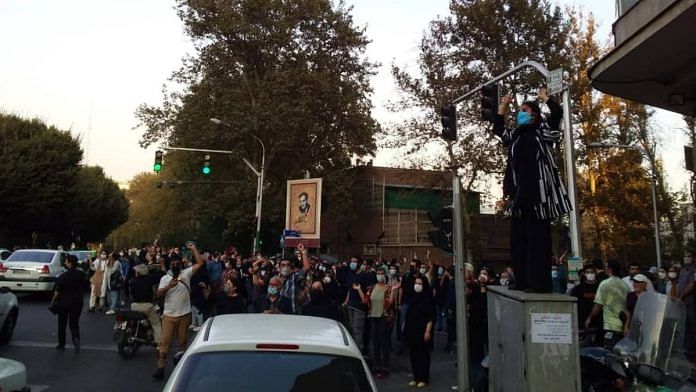
Thank you dear subscribers, we are overwhelmed with your response.
Your Turn is a unique section from ThePrint featuring points of view from its subscribers. If you are a subscriber, have a point of view, please send it to us. If not, do subscribe here: https://theprint.in/subscribe/
One of the first casualties in post-revolutionary Iran was women’s rights which included forfeiture of their faculty to choose. Imposed as a moral code, the veil (or hijab) became a legal offense in 1983 during the first presidency of Ali Khamenei, who has served as the Supreme Leader ever since Khomeini died in 1989.
After the Revolution, there was a concurrent evolution of two narratives in the country: the ‘need of liberalizing the hijab restrictions’ led by so-called reformists, and the ‘demand for more strict enforcement of hijab’, espoused by the hardliners.
If Rafsanjani (1989-97) and Khatami (1997-2005) attempted to champion the permissive hijab code, Ahmadinejad (2005-13) sought stricter enforcement. Under Rouhani (2013-21), the hijab issue became more divisive. Rouhani’s decision to publish a government report that showed a stark change in public opinion about imposed dress codes also contributed to such divisions.
Meanwhile, the protest movements against mandatory hijab also became vocal and widespread. Finally comes the Raisi presidency that was hailed as the beginning of a new era of ultra-conservatism in Iran. Such analyses proved true when his government introduced changes to the hijab code.
In early-August, the powerful Supreme Cultural Council of Iran met to remove the legal penalty for mandatory hijab that was signed-off by Raisi the same week. This could have been a positive development if the government had not chosen to empower the morality police. What happened as a result was frequent incidents of violence against women.
Several women have since been dragged and assaulted by the morality police over what it calls the ‘bad hijab’. The government has allowed the use of facial recognition software in public places to find women not observing hijab code and punishing them by social exclusion that notably includes barring entry into government offices and refusal of social services of various kinds like buses and banks.
Over the past few months, several incidents stunned the Islamic nation as women were seen dragged by the morality police, forced confessions (like that of Sepideh Rashno), and beating leading to injury (as was the case of Mahsa (Zhina) Amini) have notably occurred.
Khamenei Speaks
In the third week of protests, Supreme Leader Ali Khamenei, made his much-awaited statement. But, unlike his previous statements, Khamenei looked defensive this time.
He seemed to have understood the gravity of the protests when he spoke, “Many Iranian women who do not observe the hijab perfectly are among the steadfast supporters of the Islamic Republic.” He added, “Some of them are young people who take to the streets due to the influence of a program on the internet.”
Two significant observations can be made here.
Firstly, statements made a distinction between two kinds of women protesting against hijab: those that fail to practice the hijab code properly but support the Islamic Republic, and another are those that took to the streets only because of outside influence.
Secondly, according to Khamenei, those involved in protests are not all delinquent citizens but a few bad apples, which could be handled through “small punishment.” These may appear as semantic variances but they carry immense value once the history and context are looked at. What Khamenei is trying to do here is legitimize the status quo, while assuaging hardliners with strict actions against protestors.
This is significant given that in the past, Khamenei has doubled down on protests very early on. Contrast ongoing protests to earlier protests of November 2019, when Khamenei called protestors “thugs” and “hooligans,” and called for all “necessary measures” in handling the protests, which naturally meant violent actions. The Reuters report estimated nearly 1,500 deaths afterwards. Khamenei illustrated similar aggressive and unyielding positions during Student Protest (1999), Green Movement (2009), and protests following shooting down of the Ukrainian airliner in January 2020.
Needless to say, a lot has changed over the last decade. What is notable is that this time Khamenei’s statements had been more assuaging than ever before. This truly illustrates the anxiety within the regime. Khamenei (and his hardliner cohorts) are not known for conceding on their values and redlines. And in post-revolutionary Iran, the hijab is such a redline.
Now, was it the change of heart, or pragmatism about changing dynamics in the country that led Khamenei to make such concessions? It is hard to say for sure, but what remains sure is that protests have changed Iran and its politics for years to come.
But could this bring any reprieve for women in Iran? Such would be a definitive prediction for a country that is hard to predict. However, it’s clear that things would no longer be the same, and Khamenei’s submissive speech illustrates that for the first time hijab may become negotiable, if not entirely abandoned.
Also read: India can help end the Russia-Ukraine war. Not being part of EU may be key
These pieces are being published as they have been received – they have not been edited/fact-checked by ThePrint.

COMMENTS